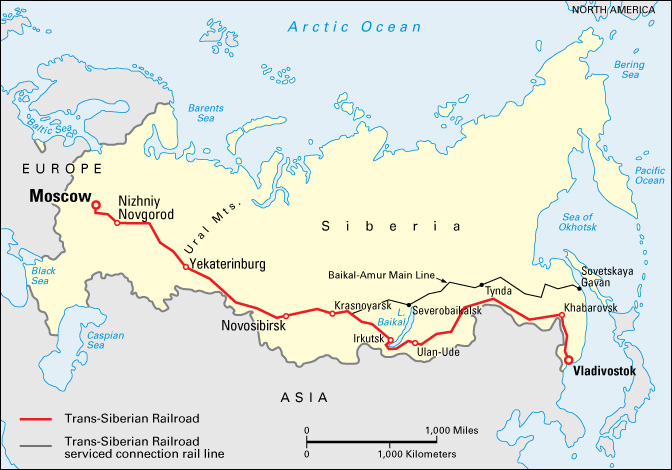Trans-Siberian Railroad is the longest continuous railroad in the world, extending over 5,600 miles (9,000 kilometers). It stretches across the width of Russia, from Moscow in the west to Vladivostok at the far southeastern tip of the country. The trip from one end to the other takes about six or seven days. Most of the railroad crosses Siberia, the vast, icy region that makes up most of the Asian part of Russia.

The Trans-Siberian Railroad brought an era of development to Siberia. Industries, trade, and mineral exploration developed along the train route. New cities and settlements sprung up along the railroad’s path. During World War I (1914-1918) and World War II (1939-1945), the Trans-Siberian Railroad was used to transport troops and supplies across the vast territory.
The Trans-Siberian Railroad, originally called the Great Siberian Railroad, was the first railroad built across Siberia. The railroad was built in several sections from 1891 to 1916. The section in eastern Siberia, between Vladivostok and Khabarovsk, was completed about 1897. From 1892 to 1912, other sections were built across western and central Siberia.
Between 1897 and 1903, Russia built the Chinese Eastern Railway across northeastern China, then known as Manchuria. This railroad connected Vladivostok with the sections of the Trans-Siberian in western and central Siberia. By 1904, a continuous railroad stretched from Vladivostok across China and Siberia to the Ural Mountains.
The Russians wanted a railroad route that did not cross China. They built a line north of China from Khabarovsk to Kuenga. Completed in 1916, it was the last link in a continuous railroad on Russian soil between Vladivostok and Moscow.
Since the 1920’s, the Trans-Siberian has been joined to other railroads. Beginning in 1929, parts of the railroad were electrified, so that electric trains could use the tracks. The project to electrify the entire Trans-Siberian Railroad was completed in 2002.
